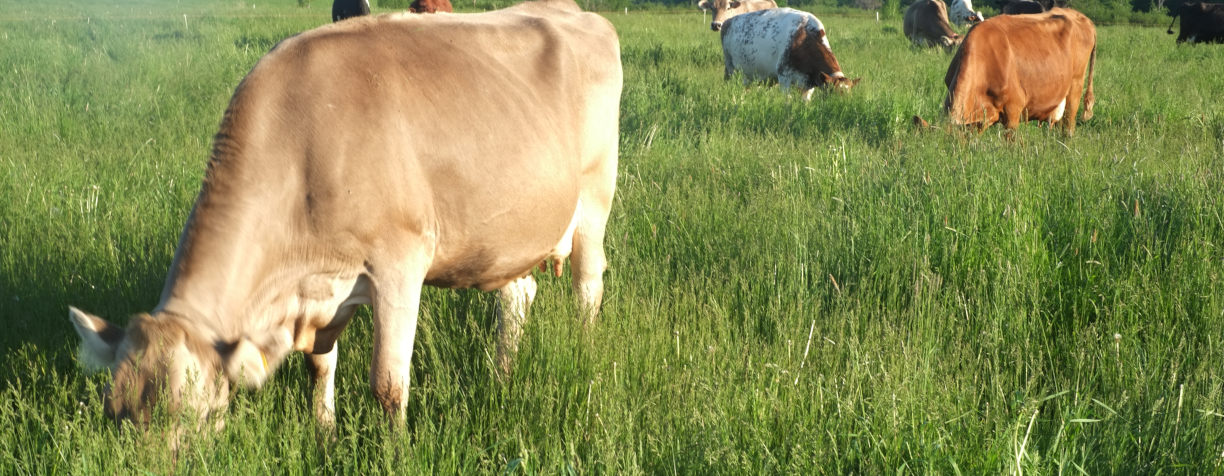Janet Fletcher
Planet Cheese
Cheese and other dairy products are getting the evil eye these days from many corners. Some voices argue that we need to be eating a more plant-based diet, both for the sake of the planet and for our own sake. I don’t disagree. But I do believe that cheese—a nutritious food that has sustained pastoral cultures around the world for millennia—is compatible with a healthy and low-impact lifestyle. The dairy farmers I know prioritize their animals’ welfare (why wouldn’t they?) and they aren’t ducking environmental concerns. They are seeking solutions.
Pasture-based dairying is one practice that is gaining traction. A handful of U.S. cheesemakers are showing the way, making award-winning cheeses (like Jasper Hill Farm’s Willoughby (pictured above), from grass-fed animals and building financially stable businesses. Could a meaningful volume of American cheese come from grass-fed livestock eventually? I recently spoke to a visionary Wisconsin dairy farmer who has creative ideas for how to make that happen.
Uplands Cheese in Wisconsin, Jacobs & Brichford in Indiana, Meadow Creek Dairy in Virginia, Jasper Hill Farm in Vermont, Green Dirt Farm in Missouri and Sweet Grass Dairy in Georgia are among the American cheesemakers succeeding with a grass-based model. Their cheeses are the crème de la crème. Other cheesemakers, like Shepherd’s Way Farms in Minnesota, graze their animals as much as their climate allows.
Before I get to the Wisconsin dairy farmer with the good ideas, I’d like to share some of Kat Feete’s response when I asked her about anti-dairy sentiment. Kat’s parents started Meadow Creek Dairy in the Blue Ridge Mountains, and she is assuming much of the management now.

Pasture evangelists: Kat Feete (second from left) and family
“Our land is absolutely not suitable for growing crops (we're far too steep) but has thrived under management-intensive grazing. For as much food as it creates, grazing needs minimal input. We use very little fuel and about 10 percent of the fertilizer that would be recommended to grow food on our land. The pastures’ deep root structure minimizes agricultural runoff and is a huge carbon sink. It's difficult to estimate just how much carbon we sequester, but a study done on White Oak Farms , which uses similar management techniques, found a net negative for emissions due to the amount of carbon sequestered.
“In the car-happy USA, suburbs displacing farms is a bigger carbon threat. Transport produces about triple the greenhouse gases of agriculture (according to the EPA) . The average New Yorker would have far more impact on their personal carbon footprint by biking to work than by skipping the cheese plate.”

Solution driven: Joe and Christy Tomandl
Joe Tomandl and his wife, Christy, own three small dairy farms in Wisconsin, each with 180 to 200 cows. They practice rotational grazing on all of them. Almost 15 years ago, Joe got the idea for an apprenticeship program to teach these environmentally friendly methods to young dairy farmers. “You can’t teach managed grazing in a classroom,” Tomandl told me. “It needs to be experiential learning.”
Today the Dairy Grazing Apprenticeship is a federally approved program, operating on 200 farms in 15 states. Uplands Cheese and Jasper Hill Farm will host apprentices next year.
Apprenticeship graduates don’t magically have the capital to invest in a dairy farm but “they can do it step by step,” says Tomandl. Working with an older farmer who wants to transition, an apprentice gradually earns equity in the farm’s cattle, equipment and land. What a smart way to spread the gospel of managed grazing.

Al fresco dining: Grass-fed herd at Jasper Hill Farm
But the story gets better. Tomandl is also working on a promising alternative to ever-bigger dairy farms, the industry trend. What if, instead of a single large dairy farm, you had a cluster of 10 small farms that pooled their milk? “We can build a 2,000-cow unit out of ten 200-cow grazing dairies,” says Tomandl. “So you’ve got an efficient volume of milk and a much more appropriate ratio of cattle to land base.” The pooled milk might be utilized for a branded cheese that could fetch a premium for its pasture-raised credential.
Working with the University of Wisconsin, Tomandl instigated a research project comparing row-crop farms (corn and soybeans) to a pasture-based dairy farm. By every ecosystem measure—from carbon sequestration to soil erosion, nutrient runoff and wildlife habitat —the managed pasture was “head and shoulders above” the cropland , says Tomandl. You can learn more here.
Other studies have also found that managed grazing, done right, results in more carbon sequestration than carbon emissions.
The key to profitability for these small dairy farms, says Tomandl, is getting compensated for the carbon sequestration. If farms can measure, verifiably, how much carbon they sink in their pastures (and there are now tools to do so), this resource could potentially be bundled and traded on a carbon-offset market.
“A lot of European farm subsidies are built around the positive impact of the farms,” says Andy Hatch of Uplands Cheese. “There is a model for this in Switzerland and Austria. The main question is whether the money would come from the market or the government. But I don’t see why farming systems that mitigate environmental problems shouldn’t receive some value for that.”
As consumers, we can support this managed-grazing movement with our cheese purchases. The creameries that work, as much as possible, with milk from livestock on managed pasture deserve our encouragement, not our abandonment.


